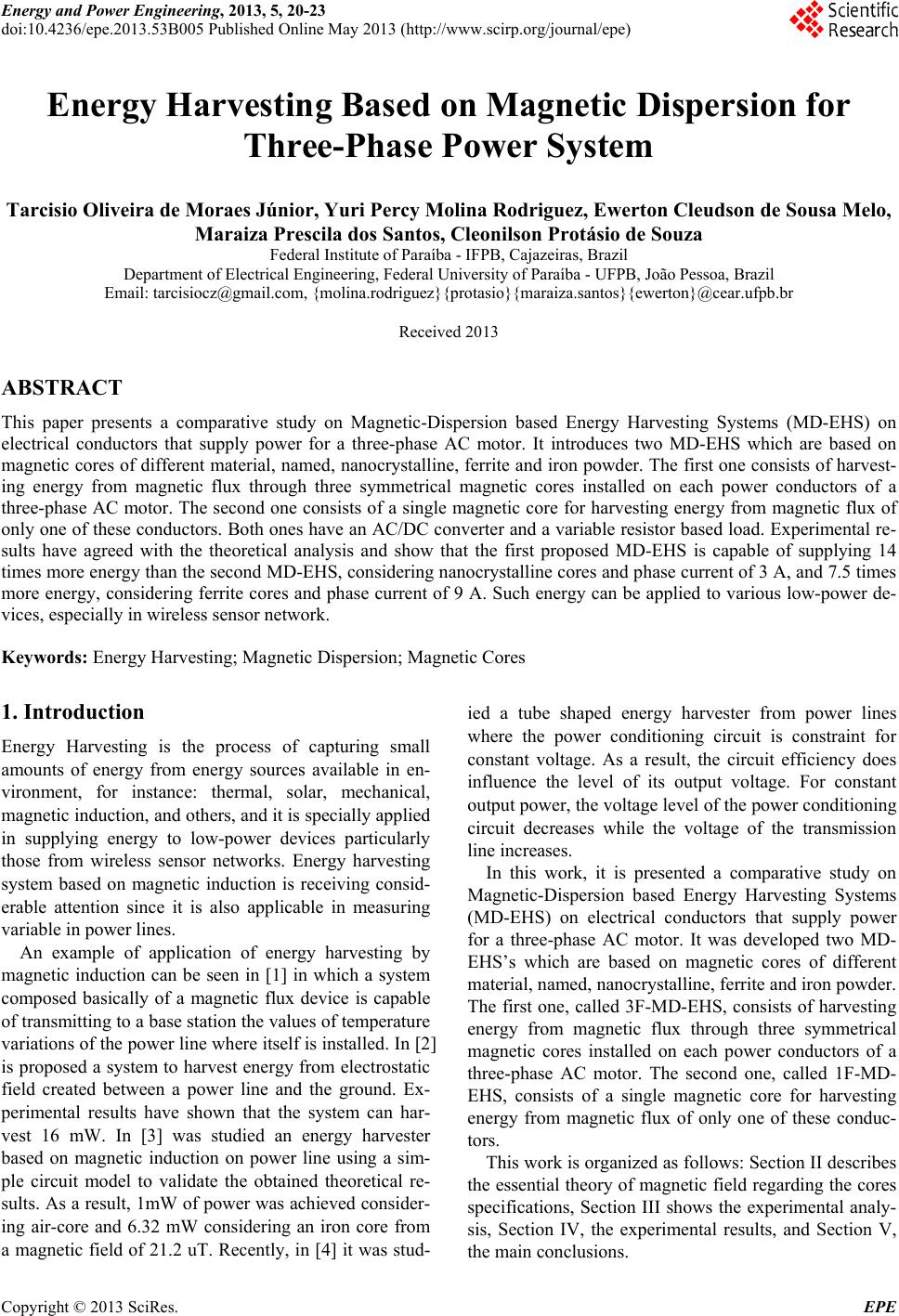
Energy and Power Engineering, 2013, 5, 20-23
doi:10.4236/epe.2013.53B005 Published Online May 2013 (http://www.scirp.org/journal/epe)
Energy Harvesting Based on Magnetic Dispersion for
Three-Phase Power System
Tarcisio Oliveira de Moraes Júnior, Yuri Percy Molina Rodriguez, Ewerton Cleudson de Sousa Melo,
Maraiza Prescila dos Santos, Cleonilson Protásio de Souza
Federal Institute of Paraíba - IFPB, Cajazeiras, Brazil
Department of Electrical Engineering, Federal University of Paraíba - UFPB, João Pessoa, Brazil
Email: tarcisiocz@gmail.com, {molina.rodriguez}{protasio}{maraiza.santos}{ewerton}@cear.ufpb.br
Received 2013
ABSTRACT
This paper presents a comparative study on Magnetic-Dispersion based Energy Harvesting Systems (MD-EHS) on
electrical conductors that supply power for a three-phase AC motor. It introduces two MD-EHS which are based on
magnetic cores of different material, named, nanocrystalline, ferrite and iron powder. The first one consists of harvest-
ing energy from magnetic flux through three symmetrical magnetic cores installed on each power conductors of a
three-phase AC motor. The second one consists of a single magnetic core for harvesting energy from magnetic flux of
only one of these conductors. Both ones have an AC/DC converter and a variable resistor based load. Experimental re-
sults have agreed with the theoretical analysis and show that the first proposed MD-EHS is capable of supplying 14
times more energy than the second MD-EHS, considering nanocrystalline cores and phase current of 3 A, and 7.5 times
more energy, considering ferrite cores and phase current of 9 A. Such energy can be applied to various low-power de-
vices, especially in wireless sensor network.
Keywords: Energy Harvesting; Magnetic Dispersion; Magnetic Cores
1. Introduction
Energy Harvesting is the process of capturing small
amounts of energy from energy sources available in en-
vironment, for instance: thermal, solar, mechanical,
magnetic induction, and others, and it is specially applied
in supplying energy to low-power devices particularly
those from wireless sensor networks. Energy harvesting
system based on magnetic induction is receiving consid-
erable attention since it is also applicable in measuring
variable in power lines.
An example of application of energy harvesting by
magnetic induction can be seen in [1] in which a system
composed basically of a magnetic flux device is capable
of transmitting to a base station the values of temperature
variations of the power line where itself is installed. In [2]
is proposed a system to harvest energy from electrostatic
field created between a power line and the ground. Ex-
perimental results have shown that the system can har-
vest 16 mW. In [3] was studied an energy harvester
based on magnetic induction on power line using a sim-
ple circuit model to validate the obtained theoretical re-
sults. As a result, 1mW of power was achieved consider-
ing air-core and 6.32 mW considering an iron core from
a magnetic field of 21.2 uT. Recently, in [4] it was stud-
ied a tube shaped energy harvester from power lines
where the power conditioning circuit is constraint for
constant voltage. As a result, the circuit efficiency does
influence the level of its output voltage. For constant
output power, the voltage level of the power conditioning
circuit decreases while the voltage of the transmission
line increases.
In this work, it is presented a comparative study on
Magnetic-Dispersion based Energy Harvesting Systems
(MD-EHS) on electrical conductors that supply power
for a three-phase AC motor. It was developed two MD-
EHS’s which are based on magnetic cores of different
material, named, nanocrystalline, ferrite and iron powder.
The first one, called 3F-MD-EHS, consists of harvesting
energy from magnetic flux through three symmetrical
magnetic cores installed on each power conductors of a
three-phase AC motor. The second one, called 1F-MD-
EHS, consists of a single magnetic core for harvesting
energy from magnetic flux of only one of these conduc-
tors.
This work is organized as follows: Section II describes
the essential theory of magnetic field regarding the cores
specifications, Section III shows the experimental analy-
sis, Section IV, the experimental results, and Section V,
the main conclusions.
Copyright © 2013 SciRes. EPE